
* During the Second World War, the Soviet design bureau led by Artyom Mikoyan designed a series of piston-engine fighters, none of which proved entirely satisfactory and most of which were purely experimental. Such efforts would, however, give Mikoyan the background to develop highly successful jet fighters in the postwar period. This document provides a history and description of Mikoyan's piston fighters.
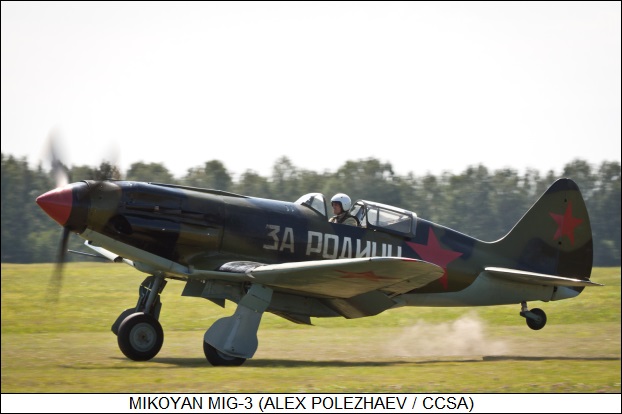
* The Soviet Union employed a distinctive scheme for aircraft development, with aircraft designs implemented by several government "design bureaus", or "OKB" in the Russian acronym, with manufacturing provided by one or more separate "state factories", or "GAZ" in the Russian acronym. A GAZ could be assigned production of various types of aircraft from different OKBs, depending on need and the dictates of state planning committees.
One of the most famous aircraft OKBs was established by Artyom I. Mikoyan and Mikhail Y. Gurevich before the beginning of World War II, as a spin-off from the aircraft OKB run by Nikolai N. Polikarpov, and was ultimately given the designation "MiG" from the two men's initials. Mikoyan and Gurevich had been working for Polikarpov on a high-altitude interceptor design for the VVS (Voyenno Vozdushniye Sily / Red Air Force); they were given their own OKB to take the design through full development. They quickly rolled out a prototype, designated the "I-200", where "I" stood for "Istrebitel (Fighter)", which performed its first flight on 5 April 1940, with test pilot Arkadiy N. Yekatov at the controls. A second prototype was rolled out in May, followed by a third in June.
The I-200 was designed somewhat along the lines of an air racer, being literally built around the new Mikulin AM-35A liquid-cooled V-12 engine offering 1,010 kW (1,350 HP), with the engine boosted by supercharging to provide 895 kW (1,200 HP) at 6,000 meters (19,750 feet); it drove a three-bladed variable-pitch propeller. Mikoyan and Gurevich wrapped the engine in the most minimal fuselage possible, with the cockpit set well back in air-racer style, and with a relatively big wing for combat maneuverability. The USSR had a shortage of light aviation alloys, and so the only parts of the aircraft that were built of metal were the nose and the center section. The rest of the aircraft was made of wood. It had retractable taildragger landing gear with a wide track -- an important feature for rough field airstrips. The main gear retracted inward from the wings towards the fuselage; the tailwheel also retracted.
Flight tests were completed by mid-September 1940. The I-200 proved to have excellent performance, with a maximum speed of 648 KPH (403 MPH). The forward view from the rear-set cockpit was also poor, the cockpit was a hotbox, longitudinal stability was shaky, and the aircraft had an unfortunate tendency to snap into a spin if flown carelessly. It was not an aircraft that could be easily flown by a novice pilot. Nonetheless, the USSR was expecting war in the near future, and so the aircraft was ordered into limited production as the "MiG-1", while some of the bugs were worked out. A hundred MiG-1s were built into December 1940.
_________________________________________________________________
MIKOYAN MIG-1:
_________________________________________________________________
wingspan:
10.2 meters (33 feet 6 inches)
wing area:
17.44 sq_meters (187.73 sq_feet)
length:
8.16 meters (26 feet 10 inches)
height:
2.62 meters (8 feet 7 inches)
empty weight:
2,602 kilograms (5,736 pounds)
loaded weight:
3,100 kilograms (6,830 pounds)
speed / sea level:
485 KPH (300 MPH / 260 KT)
speed / 7,200 meters:
630 KPH (390 MPH / 340 KT)
service ceiling:
12,000 meters (39,500 feet)
range:
580 kilometers (360 MI / 315 NMI)
_________________________________________________________________
Production aircraft were fitted with twin 7.62-millimeter (0.30-caliber) ShKAS machine guns and a single 12.7-millimeter (0.50-caliber) UBS machine gun, all mounted in the nose and firing through the propeller arc using synchronizing gear. That was somewhat light armament, though in compensation Soviet machine guns tended to have rates of fire as much as 50% greater than Western equivalents. The production machines were also fitted with self-sealing fuel tanks, cockpit armor, and provisions for carrying a 50-kilogram (110-pound) or 100-kilogram (220-pound) bomb under each wing. The first eight MiG-1s had side-hinged canopies that couldn't be jettisoned, while the rest had jettisonable rear-sliding canopies.
The additional weight of guns and armor, as well as poor mass-production finish, reduced top speed by 20 KPH (12 MPH), but the MiG-1 was still the fastest fighter the USSR had when it was accepted into service in April 1941.
BACK_TO_TOP* When MiG-1 production was terminated in December 1940, the type was replaced on the manufacturing line by the modestly improved "MiG-3", which also went into service in April 1941. The MiG-3 retained the same engine and armament as the MiG-1, at least in initial production, though later production featured updated armament. Changes in the MiG-3 from the MiG-1 included:
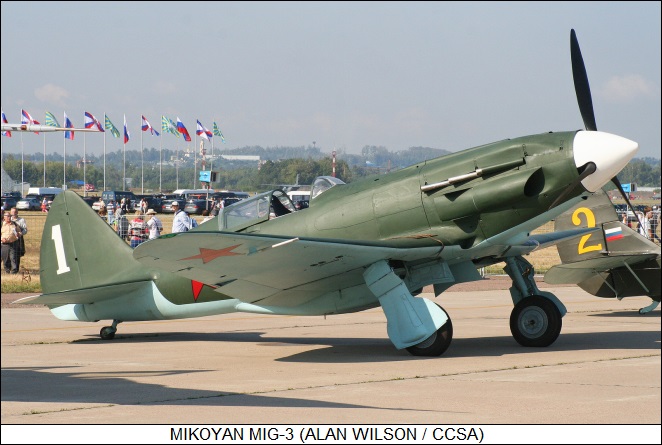
Following the German invasion of the USSR on 22 June 1941, the MiG-3 was the best fighter in service with the VVS. Production was interrupted when the factory had to be relocated from the Moscow area to Kuibyshev (Samara) in October 1941 to stay out of the path of the German advance. Through superhuman efforts, production was resumed in Samara quickly, with the MiG-3 become one of the primary fighters of the VVS during 1942. The limited firepower was a problem, and so about 820 fighters were refitted with a Berezin BK 12.7-millimeter machine gun in a pod under each wing to complement the standard armament. The pods cut speed and maneuverability, however; pilots thought them a bad idea, the pods often being removed in the field.
_________________________________________________________________
MIKOYAN MIG-3:
_________________________________________________________________
wingspan:
10.2 meters (33 feet 6 inches)
wing area:
17.44 sq_meters (187.73 sq_feet)
length:
8.25 meters (27 feet)
height:
2.65 meters (8 feet 8 inches)
empty weight:
2,700 kilograms (5,950 pounds)
loaded weight:
3,350 kilograms (7,385 pounds)
speed / sea level:
505 KPH (315 MPH / 270 KT)
speed / 7,800 meters:
640 KPH (400 MPH / 345 KT)
service ceiling:
9,500 meters (31,000 feet)
range:
820 kilometers (510 MI / 445 NMI)
_________________________________________________________________
About 315 machines were built with armament of two UBS 12.7-millimeter machine guns, while about 50 were built with twin ShVAK 20-millimeter cannon. However, the VVS was getting better fighters, and there was competition for production resources -- manufacture of the Mikulin AM-35A engine was discontinued in late 1941 to allow more production of the AM-38 engine, used in the critical Il-2 Shturmovik close-support aircraft. One MiG-3 was fitted with an AM-38 to see if it could be used as an alternative powerplant, but the conclusion from trials was that it would require substantial modification of the engine. That wasn't going to happen, and so ended MiG-3 production after the completion of 3,172 machines.
* In the West, the MiG-3 has been characterized as fast but unmaneuverable, mostly used in the reconnaissance role. That doesn't seem to be exactly true, the well-known test pilot Vladimir Kokkinaki of the Ilyushin OKB writing that during the defense of Moscow in late 1941 the MiG-3 proved an "advanced and maneuverable fighter". It was, however, unforgiving, Soviet ace Aleksandr Pokryshkin comparing it to a high-strung racehorse: "Under a skillful rider it rushed along like an arrow, but when you lost control, you could end up under its hooves."
It was the most important fighter of the VVS in the first year of the war in the East, even though it was not quite the equal of the Messerschmitt Bf 109E except at higher altitudes, where combat rarely took place. Along with lacking the edge and touchy handling, working out teething problems proved an extended exercise, and the MiG-3 didn't really get up to a satisfactory state of production quality until late in its short manufacturing life. With improved fighters available, the MiG-3 was generally relegated to rear-area service as an interceptor; it was generally out of service by 1944.
BACK_TO_TOP* With the MiG-3 going out of production, in late 1941 the MiG OKB investigated what could be done to build a successor. The first idea was to fit the airframe with a Shvetsov M-82A 14-cylinder air-cooled radial engine with 1,270 kW (1,700 HP). Two experimental prototypes and three preproduction machines were built, the first of these aircraft flying on 23 July 1941, with pilot M.I. Martselyuk at the controls. The type was given the OKB designation of "IKh" and the official designation of "I-210", though it was sometimes informally referred to as the "MiG-3M-82".
The forward fuselage was redesigned to accommodate the radial engine, which had a big prop spinner to improve streamlining. The aircraft was armed with three 12.7-millimeter UBS guns -- originally, two 7.62-millimeter ShKAS guns were fitted as well, but they were eventually deleted. While a production version of the aircraft, to be designated "MiG-9", was considered, flight tests showed the aircraft to have poor aerodynamics, with considerable drag, high vibration, and unpleasant handling.
* One of the I-210s was put through wind-tunnel tests at the Central Aerodynamics & Hydrodynamics Research Institute (TsAGI in its Russian acronym), and in response to the data the MiG OKB redesigned the cowling, changed the interface between the forward and rear fuselage, moved the oil coolers from the belly into the wing roots, enlarged the tailfin, and moved the cockpit aft. Armament was twin 20-millimeter ShVAK cannon, firing through the prop arc.
The new aircraft was designated the "I-211" AKA "MiG-9Ye". Ten prototypes were ordered, with the first flying on 24 February 1943, Viktor N. Savkin at the controls. The aircraft had promise, but due to various delays, trials weren't completed until early 1944, by which time interest had moved on to jet fighters. Only one I-211 was ever completed.
_________________________________________________________________
MIKOYAN I-211:
_________________________________________________________________
wingspan:
10.2 meters (33 feet 6 inches)
wing area:
17.44 sq_meters (187.73 sq_feet)
length:
7.95 meters (26 feet 1 inch)
height:
3.63 meters (11 feet 11 inches)
empty weight:
2,530 kilograms (5,575 pounds)
loaded weight:
3,100 kilograms (6,835 pounds)
maximum speed:
670 KPH (415 MPH / 360 KT)
service ceiling:
11,500 meters (37,750 feet)
range:
1,140 kilometers (710 MI / 615 NMI)
_________________________________________________________________
* Following the end of production of the MiG-3, from late 1941 the MiG OKB worked on a next-generation follow-on, designated "I-230", or "MiG-3U", where the "U" stood for "Ulushchenyi (Improved)". It used the AM-35A engine simply because some AM-35As were on hand, the intent being to go on a more appropriate engine later. The initial prototype resembled a reworked MiG-3, with an increase in length by 37 centimeters (14.7 inches), aerodynamic modifications, and an increased reliance on wood construction. Armament was twin ShVAK 20-millimeter cannon, mounted in the nose above the engine.
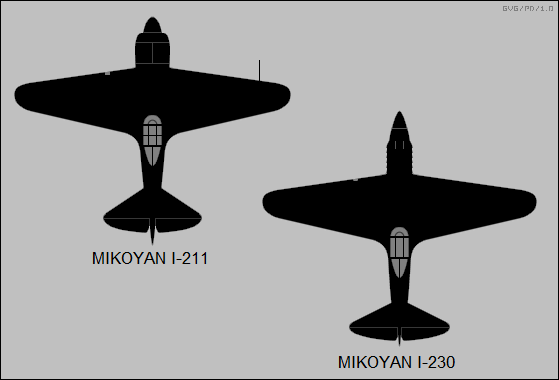
First flight was on 31 May 1943. Five more I-230s were built, with several of them performing combat evaluation. Deficiencies were uncovered; they might have been correctable, but given the I-230's reliance on the AM-35A engine, it wasn't going to enter production. The new AM-39A engine, a descendant of the AM-35A, became available in samples in September 1943, with the AM-39A mated to a further tweaked I-230 airframe, the result being designated the "I-231". Initial flight was on 19 October 1943. The I-231 suffered a series of accidents and setbacks during its flight test program, being finally abandoned after an engine failure in May 1944 -- the exercise being given up, since the decision had been made not to produce the AM-39A engine.
BACK_TO_TOP* While the MiG OKB was working on what would become the MiG-1, they were also working on a requirement for a twin-engine long-range escort fighter, or "Dalniy Istrebitel Soprovozhdenya (DIS)." The MiG OKB submitted a design with the designation DIS-200, with competitors including the Grushin Gr-1, the Polikarpov TIS, and the Tairov Ta-3.
The MiG DIS-200 was of mixed construction, part metal and part wood. It was powered by twin Mikulin AM-37 water-cooled V-12 engines providing 1,045 kW (1,400 HP) each, driving three-bladed props, and carried an armament of twin UBS 12.7-millimeter and quadruple ShKAS 7.62-millimeter machine guns. A VYa 23-millimeter cannon could be fitted in a detachable ventral pod, which could be replaced by a torpedo, a single one-tonne (2,200-pound) bomb, or combinations of smaller bombs.
The aircraft had a broad general resemblance to a de Havilland Hornet twin-engine fighter, being a low-wing twin-engine aircraft with taildragger landing gear, all gear with single wheels, the main gear retracting back into the engine nacelles and the tailwheel being fixed. The wings were in a shallow "inverted gull" configuration; the aircraft featured a twin-fin tail, and a wing whose leading edge almost merged into the nose. The cockpit was set well forward, giving the pilot an excellent forward view and all-round field of vision. The canopy slid back to open and could be jettisoned in an emergency. The nose was also partially glazed on the bottom to allow the pilot to see what was on the ground below and to the front.
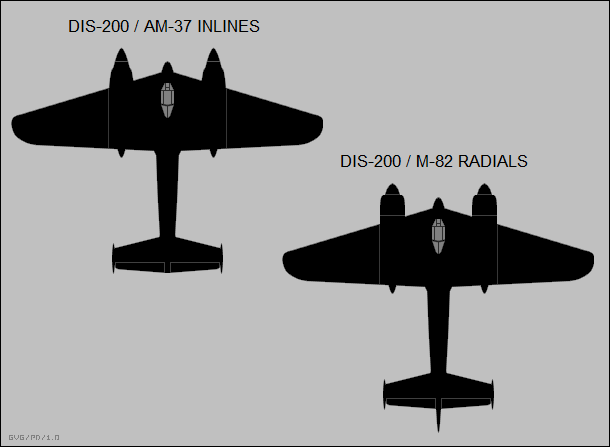
First flight of the initial DIS-200 prototype was on 11 June 1941, with Aleksandr I. Zhukov at the controls. The production machine was to be designated the "MiG-5" -- with a dedicated bomber version being considered as the "MiG-2" -- but trials showed the aircraft not close to meeting performance specs, further work being stipulated.
Examination of the design suggested that matters could be considerably improved, but partly due to the disruptions of war, the MiG-5 was never put into production, with priority being given to the Petlyakov Pe-3 twin-engine fighter instead. The Soviet Union needed weapons right away, and there was no great point in trying to get the DIS-200 up to scratch when the Pe-3 was already available and could meet the requirement.
_________________________________________________________________
MIG DIS-200 (FIRST PROTOTYPE):
_________________________________________________________________
wingspan:
15.3 meters (50 feet 2 inches)
wing area:
38.9 sq_meters (418.7 sq_feet)
length:
11.2 meters (36 feet 9 inches)
height:
3.4 meters (11 feet 2 inches)
empty weight:
6,140 kilograms (13,540 pounds)
loaded weight:
8,060 kilograms (17,770 pounds)
speed / 6,800 meters:
610 KPH (380 MPH / 330 KT)
service ceiling:
10,800 meters (35,000 feet)
range:
2,280 kilometers (1,420 MI / 1,235 NMI)
_________________________________________________________________
Nonetheless, a second prototype was completed and flew on 28 January 1943 -- sources tend to be very inconsistent on dates relevant to the DIS-200, by the way. The second prototype featured Shvetsov M-82 14-cylinder radial engines with 1,270 kW (1,700 HP) each, driving four-bladed props, and armament increased to add a second 23-millimeter cannon. It also featured a tailcone that would split open in halves to act as an airbrake. However, the program was running out of steam by that time, and no other MiG DIS-200 aircraft were built.
BACK_TO_TOP* Early in the war in the East, the Germans were operating Ju 86P high-altitude reconnaissance aircraft over Moscow and other targets in the USSR. The Ju 86P featured enhancements to permit it to fly at 13,000 meters (42,600 feet), above the ceiling of Soviet fighters, and so in July 1941 a request went out for the development of a high-altitude interceptor to shoot down such intruders. The MiG OKB came up with a design designated the "I-220", to be designated "MiG-11" if and when it went to production. Due to various delays, full development didn't start until the spring of 1942, the first of two prototypes not performing its initial flight until 26 December 1942, with Zhukov at the controls.
The I-220 was a new design, only sharing a general configuration with the MiG-3, being a single-engine fighter with a low wing and retractable taildragger landing gear. It was sleek and very aerodynamically clean, with radiators fit into the wing center section. The I-220 was of mixed construction, the fuselage being made of metal forward of the cockpit, the rest being a wooden monocoque, while the wings were spruce sheathing over metal framework. Each wing featured large split flaps, ailerons, and a leading-edge slat. The prototype was powered by a low-altitude Mikulin AM-38F engine providing 1,270 kW (1,700 HP), and armed with twin 20-millimeter ShVAK cannon above the engine, firing through the propeller arc. There were no provisions for external stores, since they were not particularly relevant to the mission. The cockpit was unpressurized, the canopy sliding back to open.
_________________________________________________________________
MIG I-220:
_________________________________________________________________
wingspan:
11 meters (36 feet 1 inch)
wing area:
20.38 sq_meters (220.10 sq_feet)
length:
9.5 meters (31 feet 2 inches)
height:
3.16 meters (10 feet 3 inches)
empty weight:
2,936 kilograms (6,488 pounds)
loaded weight:
3,574 kilograms (7,899 pounds)
speed at altitude:
650 KPH (405 MPH / 350 KT)
service ceiling:
11,000 meters (36,100 feet)
_________________________________________________________________
The AM-38F engine fit was strictly for test evaluation, since it limited the aircraft's ceiling to 9,500 meters (31,200 feet). However, performance proved excellent even with the AM-38F, suggesting the promise of the design. The I-220 was then re-engined with a Mikulin AM-39 with 1,340 kW (1,800 HP) and improved high-altitude performance, with initial flights beginning in May 1943. The engine was still in an early state of development and did not work out well, so the aircraft was refitted with the AM-38F to continue trials while the bugs were worked out of the AM-39.
A second I-220 prototype was fitted from the outset with the AM-39 and was fitted with four ShVAK 20-millimeter cannon, the added two cannon being mounted in the lower part of the nose and also firing through the propeller arc; ammunition supply was reduced from 150 to 100 rounds per gun. This second prototype first flew in early 1944, with the first prototype also refitted with the AM-39 engine and four cannon. By that time OKB engineers had decided that the I-220 would not be able to achieve its ceiling specification, and the design needed to be rethought. As discussed below, the second I-220 prototype would be resurrected in a revised form.
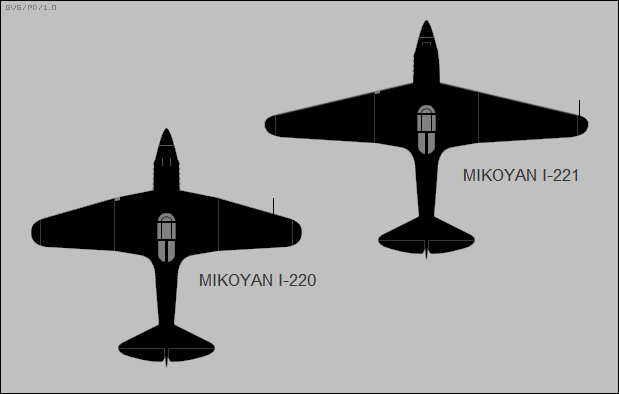
* The next prototype, the "I-221", was fitted with a long-span wing, 13 meters (42 feet 7 inches) in contrast to the 11 meter (36 foot) span of the I-220. It was to be fitted with an AM-39A engine with twin turbochargers, and was armed with twin ShVAK 20-millimeter cannon mounted low on the nose. Initial flight was on 2 December 1943, with test pilot P.A. Zhuravlyov at the controls, but it only completed eight flights before being lost on 7 February 1944. An investigation showed that the pilot had seen flames from the turbocharger system and, finding the cockpit filling up with smoke, had assumed the aircraft was on fire; he decided to bail out.
By that time, German high-altitude reconnaissance overflights were generally a thing of the past, and there was no real need for a high-altitude fighter, but research continued on the basis that such a thing might be needed in the future. OKB engineers went on to produce an "I-222" that was much the same as the I-221, except for fit of an improved turbocharged AM-39B engine, a pressurized cockpit, and the fuselage cut down behind the cockpit to improve the view from the rear.
There were other tweaky changes as well, such as an armor-glass windscreen, armored headrest, and with new SSh-20 20-millimeter cannons instead of the ShVAK weapons. First flight was on 7 May 1944. The aircraft was originally driven by a three-blade propeller, which was later swapped for a four-blade propeller specially designed for high-altitude operation. It continued in tests until July 1945, when the engine was removed for fixes and, as it turned out, never re-installed.
_________________________________________________________________
MIG I-222:
_________________________________________________________________
wingspan:
13 meters (42 feet 8 inches)
wing area:
22.38 sq_meters (241 sq_feet)
length:
9.6 meters (31 feet 6 inches)
height:
3.16 meters (10 feet 3 inches)
empty weight:
3,170 kilograms (6,980 pounds)
loaded weight:
3,790 kilograms (8,355 pounds)
speed at altitude:
690 KPH (430 MPH / 375 KT)
service ceiling:
14,500 meters (47,600 feet)
_________________________________________________________________
An "I-224" -- there was no "I-223", it was possibly a concept "not proceeded with" -- that was generally similar to the I-222 but with a different engine, an AM-39FB with an improved turbocharger, was also built, this machine being distinguished from its siblings by an oversized four-bladed propeller and a noticeable housing for the turbocharger intercooler under the nose. It performed its initial flight on 26 September 1944, with Georgiy M. Shiyanov at the controls. The I-224 performed trials into 1946, encountering various problems along the way, with the effort finally abandoned in November of that year.
* In the meantime, the Mikoyan OKB had rebuilt the second prototype of the short-winged I-220 with a new powerplant, the AM-42B with turbocharger, along with a pressurized cockpit, cut-down rear fuselage, and four SSh-20 20-millimeter cannon, with this revised machine becoming the "I-225". First flight was on 21 July 1944, with Aleksei P. Yakimov at the controls. The aircraft was lost after an engine fire on 9 August, Yakimov surviving but suffering burns. A second I-225 prototype was built, performing its initial flight on 14 March 1945, with Aleksandr P. Deyev at the controls. It was badly damaged in a take-off accident on 26 April, but rebuilt and returned to test flights in June.
OKB engineers continued their tinkerings with the machine until the program finally got the axe in March 1947, nobody having any interest in high-altitude piston fighters any longer. None of the MiG OKB's efforts along such lines came anywhere near production, though no doubt engineering work on pressurized cockpits and other high-altitude technology had benefits later on.
BACK_TO_TOP* Late in World War II, the MiG OKB developed a fighter designated the "I-250", which was one of the odder fighters ever to take to the air. Biologist Richard Dawkins once observed, contrasting technical evolution with biological evolution, that there was a discontinuity between piston and jet engines for aircraft, the two being almost completely unlike except for being combustion engines. That was true in itself -- but in the early days of jet engine development, most of the major combatants experimented with piston-jet hybrids that appear somewhat bizarre in hindsight.
One such hybrid engine, the "Vozdushno-Reaktivniy Dopolnitelniy Kompressor (VRDK)" or "jet-propelled auxiliary compressor" was developed by a Soviet engine designer named Konstantin V. Kholshchevnikov from 1942. It involved a turbojet engine of sorts, with a compressor feeding a combustion chamber, but the compressor stage was driven by a piston engine, which also drove a conventional propeller. The MiG OKB began work on the I-250, which was to be powered by the VRDK and a Klimov VK-107R piston engine, in early 1944.
Two prototypes were built, the first making its initial flight on 4 April 1945, with test pilot Aleksandr P. Deyev at the controls -- though it only had the piston engine at the time, the VRDK not being ready at the moment. The I-250 was an awkward-looking aircraft, a tailwheel monoplane with a low-mounted wing, and the cockpit set back almost to the tail. It was supposed to be armed with two 12.7-millimeter machine guns and a single 23-millimeter cannon, though it is unclear if any I-250 was ever armed.
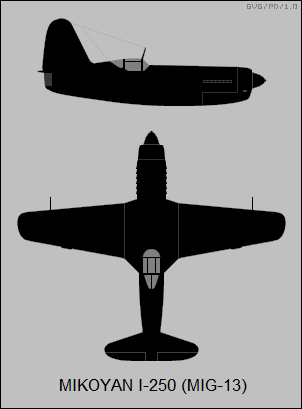
The VRDK did become available quickly enough, though it proved to have substantial teething problems. The second prototype entered flight test in May 1945. In operation, the aircraft would take off and generally fly with only the piston engine, engaging the VRDK when boost power was needed. It seemed promising enough, the fighter able to make 800 KPH (500 MPH) at altitude when the VRDK was working -- but the program suffered a setback on 5 July 1945, when the first prototype crashed, killing Deyev. The crash was due to a structural failure, not an engine problem.
_________________________________________________________________
MIG I-250:
_________________________________________________________________
wingspan:
9.5 meters (31 feet 2 inches)
wing area:
15 sq_meters (162 sq_feet)
length:
8.19 meters (26 feet 10 inches)
empty weight:
3,030 kilograms (6,690 pounds)
loaded weight:
3,930 kilograms (8,690 pounds)
speed at altitude (VRDK engaged):
820 KPH (510 MPH / 440 KT)
service ceiling:
11,900 meters (39,000 feet)
range:
800 kilometers (500 MI / 435 NMI)
_________________________________________________________________
The program went ahead, with ten preproduction machines being ordered, the expected service designation being "MiG-13". The aircraft didn't seem all that promising as a frontline fighter, but it was seen as useful for conversion training of prop pilots to jet aircraft. Things did not go smoothly, with the exercise running into one problem after another; program officials were sacked, and then arrested for "sabotage" -- the USSR having a terrifyingly broad definition of the term at the time. The second prototype was written off after a crash landing on 12 July 1946, though the first preproduction machine flew in August.
However, the program was running out of steam; at a meeting on 29 November 1946 chaired by Soviet dictator Josef Stalin, the decision was to not go to production with the I-250 -- pure jet aircraft being seen as much more promising, though Stalin wanted trials to continue as a hedge. The VVS had no further interest in the I-250 and so the Red Navy took over trials, if not with any real energy. The program was finally abandoned in the spring of 1948.
Incidentally, the Sukhoi OKB also developed a fighter based on the VRDK, the "I-107" AKA "Su-5". It was another awkward-looking aircraft, with only one prototype built, which performed test flights in 1945. Its VK-107 engine was badly damaged in a test flight during the summer of that year; the I-107 was then abandoned, the decision being made to focus on the I-250, which was then abandoned in turn. There are reasons why the piston-jet hybrid engines have been forgotten.
BACK_TO_TOP* For want of a better place to put this, not long after the end of the war, the MiG OKB developed what would turn out to be one of its last piston-powered aircraft, and what appears to be the only light civil aircraft the organization ever flew -- the "MiG-8".
The aircraft started life in 1945 as a demonstrator to test out the canard (tail first) aircraft configuration for potential jet fighter designs. Rather than simply throw together a single-seat demonstrator, OKB engineers designed the MiG-8 as a three-seat sport aircraft. It was named "Utka (Duck)", since "canard" is actually French for "duck", reflecting the rear-winged configuration of a canard aircraft.
The MiG-8 performed its first flight late 1945, with Aleksei N. Grinchik at the controls. Canard aircraft tend to be exotic-looking, but the MiG-8 was extreme. It was of wood and fabric construction, with a high-mounted strut-braced swept wing in the rear and a tailplane on a slender extended nose that suggested a duck's bill. There were twin triangular tailfins, originally mounted on the wingtips, then moved into midwing; the wings had a fixed slat on the front of the outer sections of the span. All flight controls were manual.
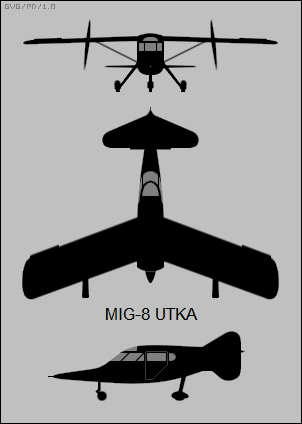
The Utka featured fixed tricycle landing gear, all with single wheels, the main gear having spats. The powerplant was a Shvetsov M-11FM five-cylinder air-cooled radial engine with 82 kW (110 HP), driving a two-bladed fixed-pitch wooden propeller mounted in pusher configuration on the rear. The pilot sat forward, with an excellent view over the duckbill nose, with two passenger seats in parallel behind; entry and exit were through car-style doors on each side of the fuselage. The MiG-8's performance turned out to be good for its class, and its handling was excellent, the machine being judged as "spinproof"; it also promised to be cheap to manufacture.
_________________________________________________________________
MIG-8 UTKA:
_________________________________________________________________
wingspan:
9.5 meters (31 feet 2 inches)
wing area:
15 sq_meters (162 sq_feet)
length:
7 meters (22 feet 11 inches)
empty weight:
640 kilograms (1,415 pounds)
loaded weight:
1,150 kilograms (2,535 pounds)
speed at altitude:
205 KPH (125 MPH / 110 KT)
range:
500 kilometers (310 MI / 270 NMI)
_________________________________________________________________
However, the MiG OKB couldn't interest anyone in putting the Utka into production, possibly because it was so bizarre in appearance, and so no more were built. That is a little puzzling because Soviet engineering was inclined to the solidly pragmatic, with looks being a secondary issue at most. In any case, the demonstrator was kept in service with the OKB as a liaison aircraft, proving sturdy and reliable in years of use. One wonders whether OKB engineers were ever very serious in thinking the MiG-8 might go into production; it might have been more the case that they decided to build the demonstrator as a three-seater because they thought it would be a fun toy to have -- and if somebody wanted to produce it, so much the better.
* This writeup turned out to be a bit of a chore. I needed to cover the MiG piston fighters to complete my set of articles on MiG aircraft, but the history of the MiG fighters in World War II seems distinctly lackluster and tedious to wade through. Certainly, many of the MiG OKB's piston-engine designs were evaluated as competent enough, and their failure to reach volume production was often due to circumstances, but there was nothing in the story that hinted that in the Cold War period, the name "MiG" would become synonymous with Soviet fighters, and MiG designs would challenge or best their competitors from Western nations who believed themselves technically superior.
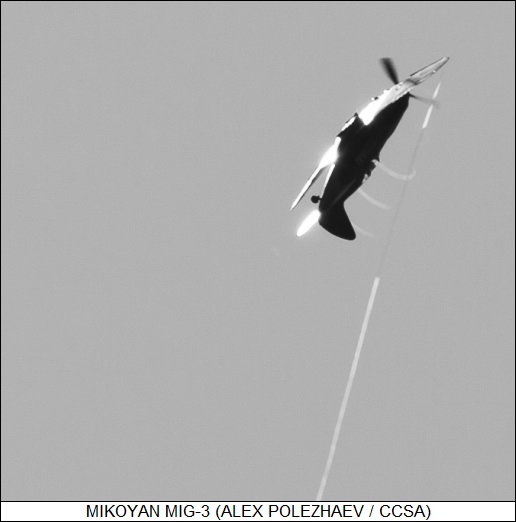
Incidentally, MiG engineers also came up with a preliminary design for a "Shturmovik", a close-support aircraft, designated the "PBSh-1", which had a distinct, if not perfect, resemblance to a Hawker Hurricane armed with heavy cannon. More interestingly, they enhanced the same design to the "PBSh-2", which was a biplane, adding a relatively small upper wing. Why the biplane configuration? Short take-offs? More warload? Greater agility? All of the above? Who knows? The authorities chose the Ilyushin Il-2 instead, and the PBSh-2 never came close to being built.
* Sources include:
* Revision history:
v1.0.0 / 01 mar 12 v2.0.0 / 01 aug 13 / Added MiG-8 Utka. v2.0.1 / 01 jul 15 / Review & polish. v2.0.2 / 01 jun 17 / Review & polish. v2.0.3 / 01 apr 19 / Review & polish. v2.0.4 / 01 mar 21 / Review & polish. v2.0.5 / 01 jan 23 / Format change. v2.0.6 / 01 dec 24 / Review & polish. (**)BACK_TO_TOP
